
White-Tail Deer: White-tail deer are the most popular big game animals in the United States. Colorado's white-tail deer roam along the rivers of the eastern plains. They are very shy mammals with smaller ears and antlers than mule deer. White-tail deer are tan and white in color and move gracefully. They point their white tails straight in the air to warn other deer when they are in danger. White-tail deer have played a very important part in the history of our country. Native Americans and early settlers used white-tail deer for food and clothing.
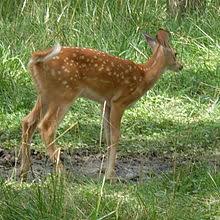
Bison: Bison are huge, hairy mammals with very large chests and small white horns on either side of their bearded faces. Their bodies are brown in color and their large heads and front legs are covered with long, dark brown woolly hair. Male bison, called bulls, are ten feet long and can weigh almost 2,000 pounds. Female bison, called cows, are more than six feet long and weigh up to 1,000 pounds. Bison used to roam freely in Colorado. In 1897, Colorado's last free roaming bison was killed. Today, there are a few captive bison herds in Colorado.
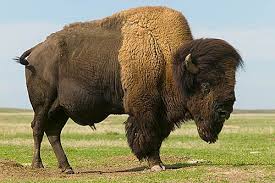
Bighorn Sheep: Rocky Mountain bighorn sheep are Colorado's state mammals. In fact, Colorado is home to the largest population of bighorn sheep in the world. Colorado's bighorn sheep are found only in the Rocky Mountain region. Bighorn sheep have extremely good eyesight, very short tails, and pointed ears. The horns of male sheep are larger and curlier than the horns of famile bighorn sheep. Unlike most other types of sheep, bighorn are covered with an outer layer of brown hair instead of wool. The under parts of bighorn sheep are gray and their tails are white.
 SMALLER MAMMALS
SMALLER MAMMALS
Coyote: Coyotes can be found all over the state of Colorado. Their name means "barking dog" and you will know when coyotes are near by their howls and yelps. Coyotes sleep during the day and hunt at night for smaller animals, insects, plants, and garbage. They will even attack larger animals that have been weakened by age, injury, or illness. Coyotes have thick brown fur and white under parts. You'll notice that when coyotes run, they keep their black tipped tails down low so they can sneak up on their prey.
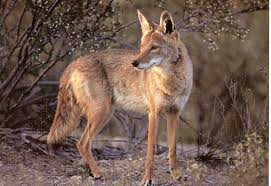
Kangaroo Rat: Kangaroo rats live throughout Colorado's eastern plains and along the major river valleys of the Colorado Plateau region. The white-tipped tails of kangaroo rats are longer than the rest of their gray bodies. They dig holes at the base of many plants where they gather seeds in the pouches of their cheeks to carry back to their dens. They are up to 11 inches long, but they only weigh about 3 oz. They are able to conserve water very well. They can often go their entire lives without actually drinking. They get all the water they need fromt he seeds and plants that they eat. Newborn kangaroo rats are blind and hairless with short tails. They grow very quickly and are full grown in about six weeks.

Gray Fox: There are four species of foxes found in Colorado. Red foxes, gray foxes, swift foxes, and kit foxes all make their homes in different areas of Colorado. Red and gray foxes are three feet long and weigh nine to eleven pounds. Swift and kit foxes are much smaller, weigh about six pounds, and their tails are as long as their bodies. All of Colorado's foxes eat rodents, rabbits, and birds. Gray foxes are unique because they will even climb trees to search for fruit and birds. Gray foxes have black-tipped tails, reddish ears and feet, and stiff black hairs on their grayish-brown backs.
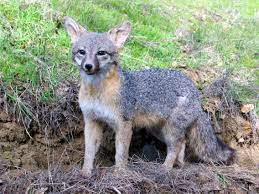
Jackrabbit: Jackrabbits are probably the most common small mammals seen moving about Colorado during daylight hours. Jackrabbits are not really rabbits at all; they are hares. Hares are different from rabbits because they take seven to ten days longer to have babies. Baby hares are born with open eyes and fur. Unlike rabbits, hares can also hop around almost immediately. There are four species of jackrabbits; two of them live in Colorado. The most common are black-tail jackrabbits. They have grayish-brown bodies and black stripes down the tops of their tails. Colorado is also home to the white-tail jackrabbits and snowshoe hares.
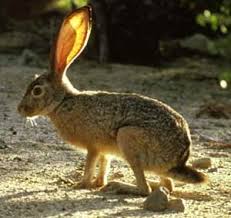
Ringtail: Ringtails are smaller mammals weighing only two pounds. They are also known as "miners' cats" because during pioneer days they were often found near mining camps. Today, ringtails can be found in southern Colorado near river valleys or springs where water can always be found. Their most striking features are their tails, which are as long as their grayish-brown bodies and striped with black and white rings. They are very good climbers and their tails help them to keep their balance. Their ankles can rotate to allown them to go head first down a cliff or tree. Ringtails hunt for food only at night and they eat mice, birds and insects.
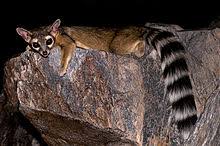
Bobcat: Bobcats are the smaller cousins of mountain lions. They can be found wandering through all three of Colorado's regions. Bobcats are big cats, weighing about 20 pounds and standing almost two feet tall. They have beautiful yellowish-orange coats and white tips on their stubby black tails. Bobcats are important to Colorado because they kill harmful rodents like rats and mice. They hunt mainly at night and can travel as many as 20 miles searching for food.
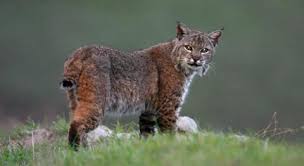
Badger: Badgers are plentiful in Colorado, but they are not commonly seen because they spend so much of their time in underground burrows. Badgers are members of the weasel family. They are carnivores that dig holes about one foot across in order to search for food. They eat ground squirrels, rodents, pocket gophers, birds, rabbits and insects. Badgers' shaggy coats are grayish-brown and they have short, bushy tails that are yellowish in color. They have short legs, long noses, and white stripes running from their noses to the tops of their backs.
